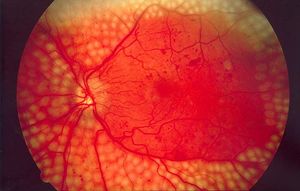One of the leading causes of blindness for adults in the United States, diabetic retinopathy is a common disease among diabetics. According to the National Eye Institute, it changes the retina’s blood vessels, causing them to swell and leak fluid. The disease progresses and may affect both of the eyes, causing vision loss. There may be no symptoms in the beginning, and it can be a complication in type 2 diabetics as well as type 1 diabetics. There are things that can lead to this type of diabetic complication, such as uncontrolled blood sugar and a long history of diabetes. Yearly eye exams and a controlled blood sugar can help decrease the progression of diabetic retinopathy. The National Eye Institute notes that between 40 and 45 percent of those with diabetes, do have some stage of diabetic retinopathy.
Symptoms
While there is generally no early signs of the condition, there are some symptoms that you will be able to notice as the condition progresses. These include blurred vision, vision loss, dark patches in vision area, fluctuating vision, spotty vision, dark strings in vision, and troubled color perception. It can affect one or both eyes but the majority have it in both eyes.
Stages of Diabetic Retinopathy
There are four different stages of the disease, according to its progression. These stages are mild nonproliferative retinopathy, moderate nonproliferative retinopathy, severe nonproliferative retinopathy, and proliferative retinopathy.
Mild Nonproliferative Retinopathy
This is the earliest stage of the eye disease and the least serious. At this point, micro-aneurysms are possible where there is swelling, much like a balloon, in the blood vessels of the retina.
Moderate Nonproliferative Retinopathy
The second stage of the disease may show some blockage of the blood vessels in the retina.
Severe Nonproliferative Retinopathy
In this third stage, there is more prominent blockage in the blood vessels. These blocked vessels cut off the blood supply to the different areas of the retina and will send the brain a signal to grow new blood vessels for added nourishment since the eye is not being nourished by the blood vessels it currently has.
Nonproliferative Retinopathy
This is the most advanced stage of the disease and the most serious. This is where those new growth blood vessels are fragile and abnormal. There is not vision loss or symptoms for these new blood vessels, but they are so fragile and have thinner walls so they will leak blood. This leaked blood is what causes the progressive vision loss leading to blindness.
While the condition can occur in anyone who has been diagnosed with diabetes, there are some risk factors that make you more likely to develop the disease. These risk factors include having diabetes for a long period of time, having high cholesterol or high blood pressure, and having poor control of your blood sugar. Smoking and pregnancy are also higher risk factors.
Sources:
National Eye Institute
http://www.nei.nih.gov/health/diabetic/retinopathy.asp
http://www.mayoclinic.com/health/diabetic-retinopathy/DS00447


